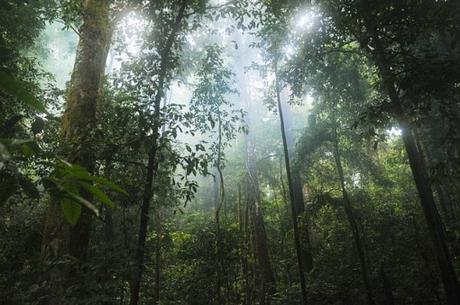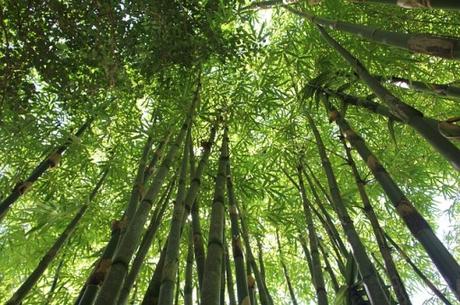Tropical Rainforests: Hot, wet, and home to millions
The tropical rainforest is one of the world’s most threatened biomes, despite being home to some of the most diverse and unique species on the planet. Many of the world’s most colorful creatures reside in rainforests, and animals from tiny organisms to large wild cats find homes amongst the range of plant life.
For many years tropical rainforests were safe from the presence of man, other than native tribal individuals who lived harmoniously with the land, but the problem of man’s encroachment on rainforests for lumber, agriculture, and development is having serious effects on the long-term survival of these regions.

Climate
Tropical rainforests are defined by the fact that they are hot and wet, typical of tropical climates. Found near the equator where it is warm, these regions have rainfall year-round, with little to no dry season. The climate of tropical rainforest biome is perfect for plant and animals growth. The hot and humid conditions create an ideal environment for the growth of bacteria and other microorganisms. They cover about 6% of the Earth‘s surface and are found all over the world but mostly in South America in Brazil. Even though they cover small percentage of land on Earth, they are home to the largest number of plant and animal species in such a concentrated area.
Location
Tropical rainforests are found in the world’s hottest and wettest areas, namely those closest to the equator. The world’s largest tropical rainforests are in Amazon basin in South America, lowland regions in Africa, and the islands off of Southeast Asia. While they are found in abundant in Sumatra and New Guinea, small areas are also found in Central America and parts of Australia.
Some of the world’s best-known rainforests are:
- The Amazon rainforest in Brazil
- El Yunque, a rainforest in Puerto Rico that attracts millions of tourists
- The Congo basin in Africa
Temperature
Tropical rainforests are warm and humid. The temperature ranges from 21 to 30 degrees celsius (70 to 85°F).
The average annual temperature of tropical rainforests is above 20 °C.
These areas often receive lots of sun due to their location around the earth’s equator. On average, rainforests receive about 12 hours of sun a day, but most of that is concentrated on the canopy cover of the highest trees.
Precipitation
It is right there in the name – rainforests are known for lots of precipitation every year. Rainfall in the tropical rainforest is year round, particularly as there are little to no seasonal changes to weather. Tropical rainforests receive annual precipitation amounts of 60 to 160 inches (152 to 406 cm). Some rainforests in the world experience annual rainfall amounts of almost 400 inches (over 1,000 cm). It can downpour as much as 2 inches (5 cm) in an hour.
Rainforests are typically classified by the amounts of precipitation they receive.
- Lowland equatorial evergreen rain forests receive the most rainfall each year, with averages of more than 80 inches annually. These rainforests are typically located closest to the equator.
- Deciduous and semi-evergreen seasonal forests have more variation in wet and dry seasons, with summers typically having higher rainfall and winters a bit lower. These can be found in coastal parts of Africa, India, the Caribbean, and parts of Central and South America.
- Montane rainforests (also sometimes known as cloud forests) are found in mountainous areas that are much cooler.
- Flooded forests: these types of rainforests closely resemble swamps, with almost constant water saturating the ground.
What is interesting about the amount of precipitation in rainforests is that because they are so moist, the soil is typically less full of nutrients because they are being flushed out by constant rain. Therefore, many plants have adapted to reach and store nutrients off the ground.
Plants of the Tropical Rainforest
The combination of lots of moisture and consistent year-round warm weather makes tropical rainforests particularly lush areas of plant life. It is estimated that tropical rainforests are home to a staggering 15 million different species of plants and animals, making them some of the world’s most diverse locations. Almost two-thirds of all of the world’s flowering plants are found in rainforests.
Because there are many large trees in the rainforest that receive year-round sunlight and precipitation, the canopy cover does not change during the year as it does in other forest biomes. Rainforests typically have three major levels of plant growth, depending on their height to the ground and how much sun and moisture reaches them.
The Canopy: This is the highest level of the rainforest, basically a roof formed by the branches and leaves of the area’s largest trees. Most of the trees reach over 120 feet in height, and combined with their dense cover can mean that little to no sunlight reaches lower areas of the rainforest. Trees at the highest level must be able to tolerate extreme sunlight and changing wind patterns.
- Large evergreen trees typically dominate the sunlight of the rainforest canopy.
- Smaller orchids, bromeliads, and types of moss and lichen are also found in the canopy level, living in harmony with the larger trees.
The Understory: This includes mid-range trees and smaller plants. This area typically receives only about 5% of the sunlight in the area, because of the density of overhead canopy. Even the largest plants in this area don’t typically grow over 10 feet (3 m.).
- Shrubs
- Herbs
- Vines
- The strangler fig is a plant that has adapted to the lower amounts of sunlight that reach the rainforest under layers. When birds eat the tree’s fruit, they spread seeds through waste and by dropping them on the branches of higher trees. This plant is able to take root on the host tree branch, drop a long root to the ground, and eventually “strangles” the host tree as it grows, by taking over its sunlight.
The Ground Stratum: Self-explanatory, the ground layer includes all of the vegetation that receives the least amount of light and is lowest to the ground. It is estimated that only 2% of sunlight actually reaches the rainforest floor. The ground in a rainforest is almost always covered by shade due to the canopy, so vegetation is more sparse and restricted at the ground layer. The bottom layer is covered with leaf litter. The hot and humid conditions allows dead leaves to decompose quickly sending nutrients back into the soil. But in the tropical rainforest, the plants grow so fast that they quickly consume the nutrients from the soil and the leftover nutrients are then leached away by abundant rainfall which leaves the soil infertile. You will find few plants on the bottom layer of forest due to lack of sunlight.
- Fungus is the most common plant life at the ground level, because fungus is able to thrive in dark, moist areas. It is often found all over the ground layer, near decaying organic matter and on trees.

Animals of the Tropical Rainforest
Rainforests are home to organisms big and small, due to their consistent warm temperatures, ample amounts of moisture, and incredibly vast amounts of plant life. There are more living organisms in tropical rainforests than there are in any other biome of the world.
The smallest organisms in a rainforest are bacteria and other similar organisms that thrive in the hot and moist environment. These tiny creatures make quick work of decomposing fallen leaves, wood, and other dead organic material, which is different from other forests in that there is little to no permanent layer of organic nutrients covering the soil.
A fascinating thing about some of the animals of the rainforest is that because the trees and plant life stay lush and fertile all year round, there are literally animal species in trop1ical rainforests who never touch the ground, remaining in the trees for their entire lives. For those that do live in the ground, the amazing vegetation from cloud cover to ground cover allows for numerous places to find protection from predators and the elements, as well as a constant source of food and nutrients.
The presence of humans in rainforests can vary. In recent decades the number of rainforests in the world has been decimated by both the lumber industries and for agricultural uses.
Small rainforest animals
- Monkeys
- Sloths move incredibly slowly and primarily hang from the trees, using their movements and body as camouflage amongst the trees. Sloths have also become attractive for certain types of algae to grow on, further camouflaging the sloths and allowing algae to reach nutrients.
- Snakes: large Boa Constrictors often live in the understory stratum, amongst the trees. Smaller species often can be found on the ground layer.
- Rodents
- Insects
- Frogs
- Birds many birds live in the canopy layer of the forest, receiving food and shelter from the canopy tree cover. Toucans have adapted their distinctive beaks as a way to reach tree fruit from a distance, since the birds are often too large to settle on these tree branches.
Mid- to large-size rainforest animals
- Tapir
- Rhinoceros
- Gorilla
- Leopards: typically live in the understory layer of rainforests
References:

